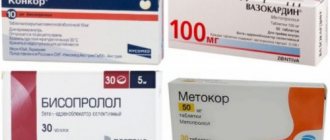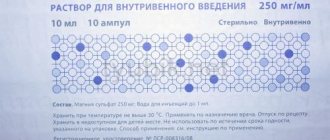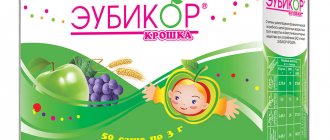Description of the drug VALSARTAN PLUS
Lithium preparations -
with simultaneous use of lithium preparations with ACE inhibitors and angiotensin II receptor blockers or thiazide diuretics, a reversible increase in the concentration of lithium in the blood plasma and an associated increase in toxic manifestations were noted. The risk of toxicities associated with the use of lithium may be further increased during concomitant use of this combination since the renal clearance of lithium is reduced by thiazide diuretics. Concomitant use of the combination of valsartan + hydrochlorothiazide is contraindicated.
Antihypertensive drugs -
it is possible to enhance the antihypertensive effect when used together with other drugs that lower blood pressure (ACE inhibitors, beta-blockers, slow calcium channel blockers, guanethidine, methyldopa, vasodilators, direct renin inhibitors, angiotensin II receptor blockers).
Pressor amines -
the effect of pressor amines (norepinephrine, epinephrine) may be weakened, without requiring cessation of joint use.
NSAIDs, including selective COX-2 inhibitors -
may weaken the antihypertensive effect of both angiotensin II receptor antagonists and hydrochlorothiazide when taken simultaneously. The simultaneous use of a combination of valsartan + hydrochlorothiazide and NSAIDs can lead to impaired renal function and an increase in potassium levels in the blood serum. If it is necessary to use this combination and NSAIDs together, renal function should be assessed and fluid and electrolyte disturbances corrected before starting treatment.
Potassium-containing substitutes for table salt; other medicines that increase serum potassium levels (for example, heparin)
requires compliance with precautions (including frequent determination of potassium levels in the blood).
Medicines that can cause hypokalemia -
The risk of hypokalemia caused by diuretics may be increased with simultaneous use of corticosteroids, laxatives, ACTH, amphotericin B, carbenoxolone, penicillin, acetylsalicylic acid or its derivatives and antiarrhythmic drugs.
Double blockade of the RAAS -
When treated with drugs that affect the RAAS, especially when they are combined, a marked decrease in blood pressure, syncope, stroke, hyperkalemia and impaired renal function (including acute renal failure) have been reported in sensitive patients. Concomitant use of the combination of valsartan + hydrochlorothiazide is contraindicated.
Caution is required when combining angiotensin II receptor blockers, including valsartan, with other drugs that block the RAAS, such as ACE inhibitors or aliskiren. Concomitant use of angiotensin II receptor blockers, including valsartan, or ACE inhibitors with aliskiren in patients with type 2 diabetes mellitus or impaired renal function (GFR < 60 ml/min/1.73 m2) is contraindicated.
Transport proteins -
According to the results of an in vitro study on hepatocyte cultures, valsartan is a substrate for the transporter proteins OATP1B1 and MRP2. Co-administration of valsartan with inhibitors of the OATP1B1 transport protein (rifampicin, cyclosporine) and with an inhibitor of the MRP2 transport protein (ritonavir) may increase the systemic exposure of valsartan (Cmax and AUC). Simultaneous use is contraindicated.
Curare-like muscle relaxants -
thiazide diuretics, including hydrochlorothiazide, potentiate the effect of non-depolarizing muscle relaxants. Simultaneous use is contraindicated.
Medicines that affect sodium levels in the blood -
The hyponatremic effect caused by diuretics may be enhanced when used simultaneously with antidepressants, antipsychotic anticonvulsants (carbamazepine). Caution should be exercised during long-term co-administration of hydrochlorothiazide with the above drugs.
Medicines that can provoke polymorphic ventricular
tachycardia of the "pirouette" type -
class IA antiarrhythmic drugs (quinidine, hydroquinidine, disopyramide); class III antiarrhythmic drugs (amiodarone, dofetilide, ibutilide), sotalol; some antipsychotics (thioridazine, chlorpromazine, levomepromazine, trifluoperazine, cyamemazine, sulpiride, sultopride, amisulpride, tiapride, pioside, haloperidol, droperidol); other drugs (bepridil, cisapride, difemanil, erythromycin IV, halofantrine, ketanserin, mizolastine, pentamidine, sparfloxacin, terfenadine, vincamine IV). Due to the risk of hypokalemia, hydrochlorothiazide should be used with caution concomitantly with drugs that can cause torsade de pointes (TdP).
Hypoglycemic agents -
Thiazide diuretics may alter glucose tolerance, which may require dose adjustments of insulin and oral hypoglycemic agents. Metformin should be used with caution due to the risk of developing lactic acidosis caused by possible renal impairment associated with hydrochlorothiazide.
Beta blockers and diazoxide -
simultaneous use of thiazide diuretics, incl. hydrochlorothiazide, with beta-blockers may increase the risk of developing hyperglycemia. Thiazide diuretics, incl. hydrochlorothiazide may enhance the hyperglycemic effect of diazoxide.
Anti-gout drugs (probenecid, sulfinpyrazone and allopurinol) -
Dosage adjustment of uricosuric agents (probenecid or sulfinpyrazone) may be required as hydrochlorothiazide may increase serum uric acid concentrations. Concomitant use of thiazide diuretics, including hydrochlorothiazide, may increase the incidence of hypersensitivity reactions to allopurinol.
Cardiac glycosides -
Hypokalemia and hypomagnesemia (undesirable effects of thiazide diuretics) may contribute to the development of cardiac arrhythmias in patients receiving cardiac glycosides.
N- and m-anticholinergics
(including atropine, biperiden) can increase the bioavailability of hydrochlorothiazide, which is associated with a decrease in gastrointestinal motility and the rate of gastric emptying. Accordingly, gastrointestinal motility stimulants (cisapride) may reduce the bioavailability of hydrochlorothiazide.
Cholestyramine and colestipol
may interfere with the absorption of concomitantly used drugs. The interval between doses should be 4-6 hours.
Vitamin D and calcium salts -
simultaneous use of hydrochlorothiazide with vitamin D or calcium supplements can lead to hypercalcemia due to increased calcium reabsorption.
Cyclosporine -
with simultaneous use of hydrochlorothiazide and cyclosporine, the risk of developing hyperuricemia and exacerbation of gout increases.
Methyldopa -
Cases of hemolytic anemia have been reported with the simultaneous administration of hydrochlorothiazide and methyldopa.
Co-administration of thiazide diuretics, including hydrochlorothiazide, may lead to an increased risk of side effects from amantadine
;
reducing the excretion by the kidneys of drugs that have a cytotoxic effect (for example, cyclophosphamide, methotrexate
), to potentiate their myelosuppressive effect.
Ethanol, barbiturates and narcotic drugs -
combined use with hydrochlorothiazide may potentiate the development of orthostatic hypotension.
When taking iodine contrast agents
in high doses against the background of a reduced volume of blood volume due to the use of diuretics, there is an increased risk of developing acute renal failure.
Pharmacodynamics and pharmacokinetics
The active substance of the drug provokes a competitive blocking of AT1 angiotensin II receptors , which are located in the vascular endothelium, cardiac muscle, adrenal cortex, renal tissue, brain and lung tissue. This leads to inhibition of angiotensin effects. The medicine reduces myocardial hypertrophy in arterial hypertension .
After a single use, the effect is noticeable after 120 minutes, it lasts throughout the day. A persistent therapeutic effect is achieved 3 weeks after the first day of the course.
In people with CHF, the medicine eliminates hyperstimulation of the RAAS , prevents pathological cell proliferation swelling . Its administration reduces preload and increases cardiac output .
When combined with K aptopril, it reduces the likelihood of post-infarction complications.
In addition, a common combination is valsartan and amlodipine . These active ingredients are found in medications such as Exforge and Vamloset .
The original drug is quickly absorbed from the gastrointestinal tract. Bioavailability on average is 23%.
Communication with plasma (mainly with albumin ) is about 95%.
Excreted mainly in feces (70%), also excreted in urine (30%), mostly unchanged.
Analogues of Valsartan
Level 4 ATC code matches:
Telmisartan
Irbesartan
Presartan
Nortivan
Candesartan
Kozaar
Aprovel
Teveten
Blocktran
Cardosal
Losartan
Atakand
Diovan
Valsacor
Mikardis
Vazar
Valz
Lorista
Lorista
Lozap
The following synonyms and analogues of Valsartan are known:
- Valz;
- Valaar;
- Valsartan A;
- Valsasin;
- Valsartan N;
- Valsartan Zentiva;
- Valsacor;
- Diovan;
- Valsafors;
- Nortivan;
- Tantordio;
- Tareg.
All of the medications listed have their own application characteristics. Valsartan analogs cannot be replaced at your own discretion, without consulting a doctor.
Instructions for use of Valsartan (Method and dosage)
For those who use Valsartan, the instructions for use indicate that the product is intended for oral use. The recommended dosage in case of arterial hypertension is 80 mg. The daily dose is taken in one dose. If necessary, the dosage can be increased to 160 mg or another antihypertensive drug can be additionally used. Instructions for use of Valsartan indicate that the maximum daily dosage is 320 mg. It is not recommended to exceed it.
Side effects
Taking this medicine may cause some unwanted effects:
- CVS and hematopoietic system: neutropenia , decreased hematocrit , hyperkalemia ;
- CNS: dizziness , weakness, headache ;
- gastrointestinal tract: diarrhea , abdominal pain , nausea, increased activity of liver transaminases ;
- other: cough, viral infections, hyperkalemia .
Adverse reactions when using the drug occur rarely.
Valsartan price, where to buy
The price of Valsartan in capsules 40 mg, 40 pieces in a pack – 130 rubles. 80 mg tablets (30 pieces in a pack) cost about 220 rubles. And the price of Valsartan in tablets of 160 mg (30 pieces in a pack) is approximately 350 rubles.
- Online pharmacies in RussiaRussia
ZdravCity
- Valsartan tablets p.p.o.
160 mg 30 pcs. Ozone LLC 360 rub. order - Valsartan tablets p.p.o. 80 mg 30 pcs. Ozone LLC
RUB 248 order
- Valsartan-SZ tab. p/o captivity. 160mg No. 30Northern Star ZAO
RUB 317 order
- Valsartan tablets p.p.o. 80 mg 30 pcs. Vertex JSC
RUB 294 order
- Valsartan tablets p.p.o. 160 mg 30 pcs. VertexVertex JSC
426 rub. order




